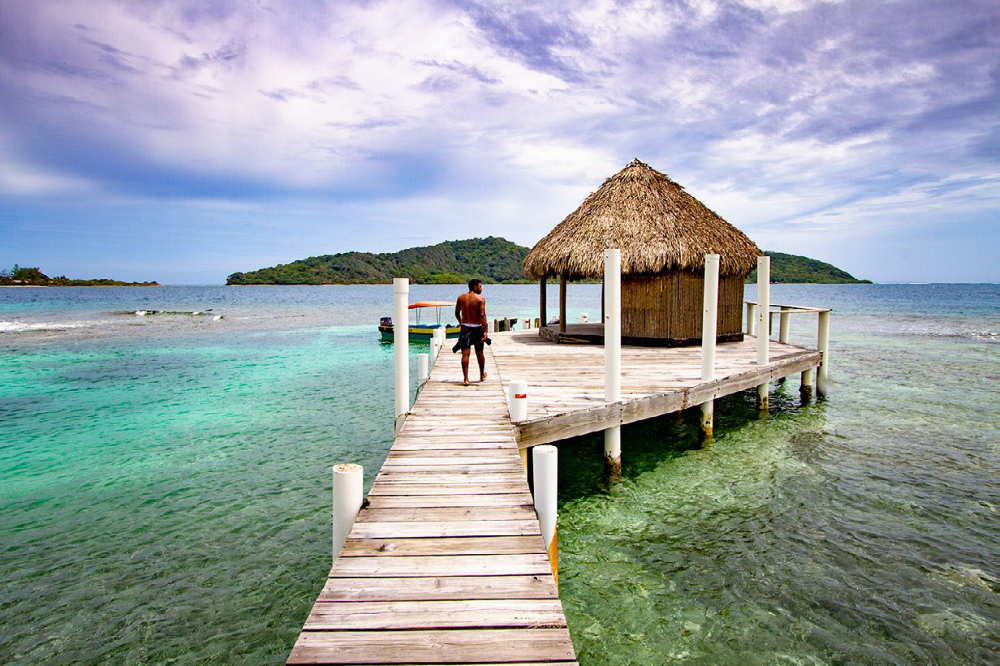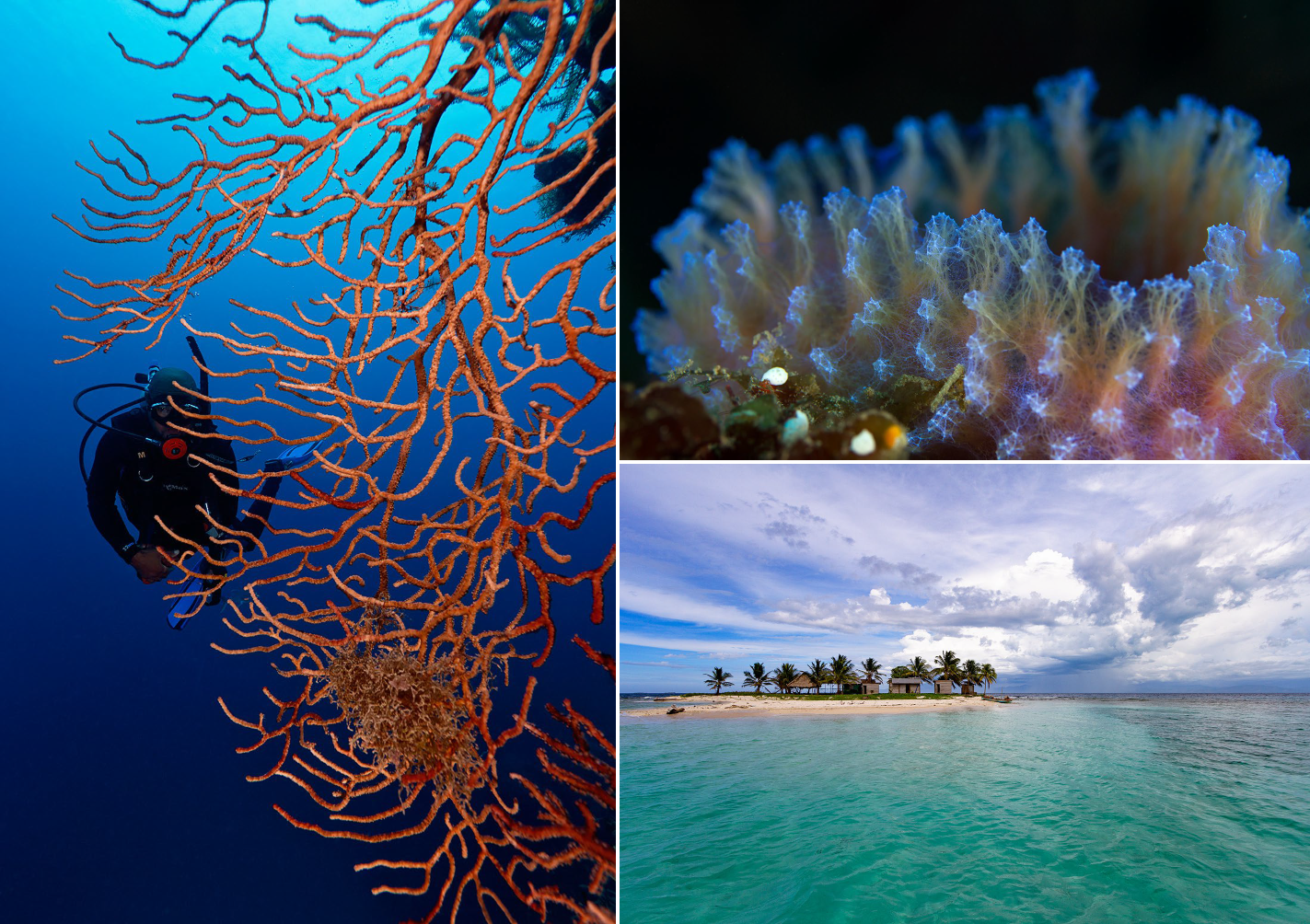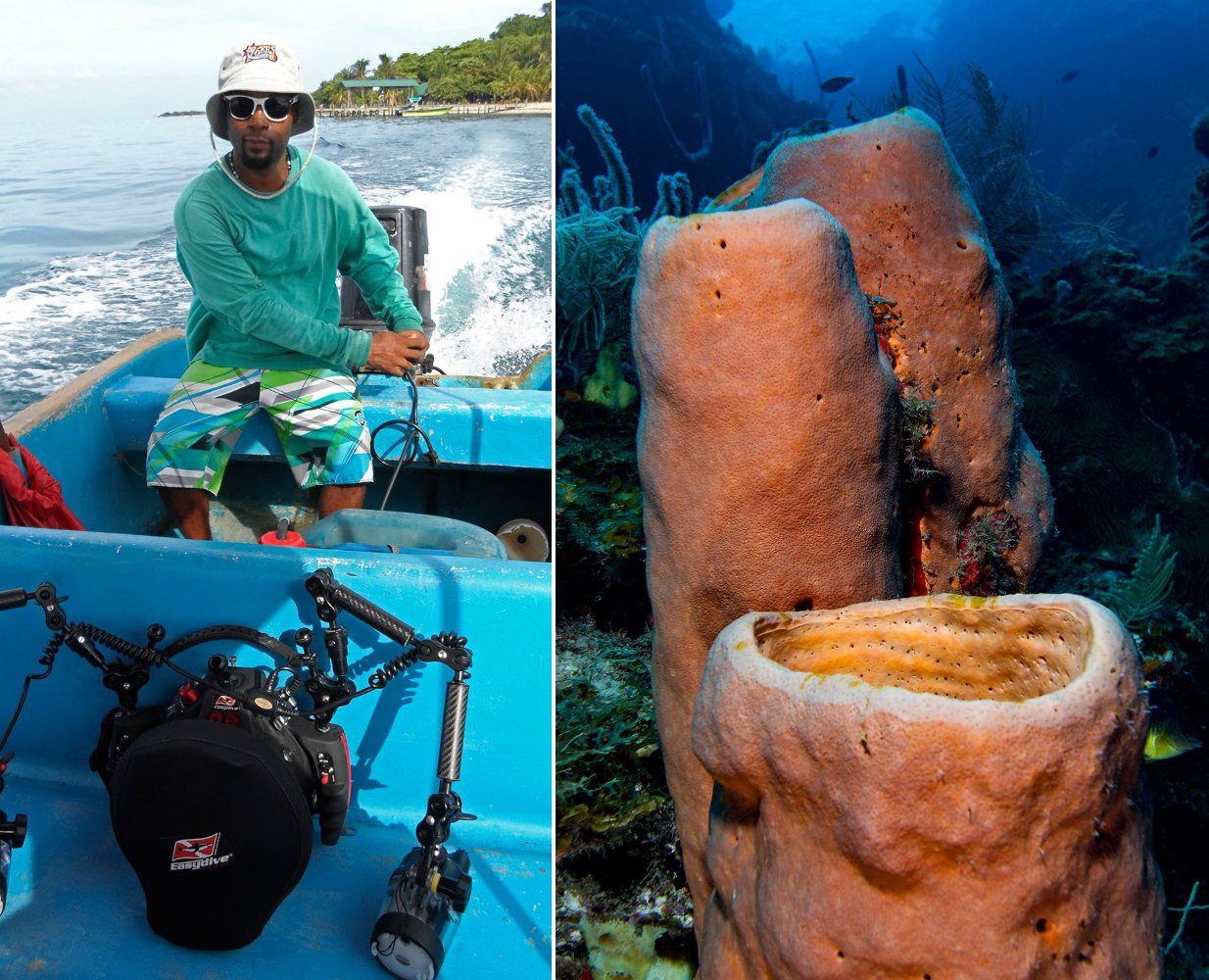We can’t say HONDURAS is unknown to scuba divers. Roatan is known and so is Utila, both of them dive locations that do attract scuba divers, mostly from the US, and do provide plenty of dive centers and all the dive logistics, keen divers do expect.
And then there are the Cayos Cochinos, a group of small islands just between the mainland of Honduras and Roatan. Cochinos Cays are a group of two small islands (15°58’18.99″N86°28’31.34″W) (Cayo Menor and Cayo Grande) and 13 more small coral cays situated 30 kilometres (19mi) northeast of La Ceiba on the northern shores of Honduras.
The Cayos are part of the Bay Islands (Islas de la Bahía ), some people still like to call them Hog Islands, referring to the famous pirate Henry Morgan who ( this it what the legends tells ) “planted” hogs on these cays so he and his pirate fellows would have meat on their return trips.
Around 100 people (Garifuna people) are living on those islands, and yes, scuba-diving is possible!

“The Cayos Cochinos reefs are the least disturbed ecosystem in the Bay Islands. The waters around this collection of coral cays are a marine biologist’s dream: protected by the government, off-limits to commercial divers and fishermen, and busy with creatures that may not yet have names”.
stated Dr. Matthias Hammer in National Geographic.
The German conservation biologist made several expeditions to this region.
Established as a key area of the Mesoamerican BARRIER REEF SYSTEM (the world’s second largest barrier reef, right after the Great Barrier Reef in Australia), the Cayos and surrounding waters were declared a marine reserve in 1993, in order to protect all marine and terrestrial flora and fauna within a 460km² area.
Laws prohibit all commercial fishing, netting, and trapping within the marine park. Local Garifuna people are permitted to fish with hand lines, but prohibited from netting and spearfishing. Since 1994, the Honduras Coral Reef Foundation is in charge to preserve the natural beauty of the area.
The Honduras Coral Reef Foundation (HCRF) has a marine-biologic research center on Cayo Menor (the smaller one of the 2 main islands) where scientists and students of marine biology from all over the world are welcome as guests to do their field researches.
Accommodation in cosy bungalows and catering is provided.
I have to confess that I love the oceans and all marine life, but I am very far away from beeing even a glimpse of a marine biologist. I apologize in advance for my inability to give proper IDs to the living things I saw during my dives.
But what I would like to share are my visual impressions and a few of my adventures, seen and experienced as a diver and photographer.
The luxus of diving places where only very few dived before, requires of course the readiness for an adventure and the willingness to accept compromises.
But it all pays back a 100 times.
If you are used to stay on huge dive boats, have others preparing your scuba gear while you sip your morning coffee on the upper deck, you might need to re-think your expectations. Because on Cayos Cochinos it’s different.
Most of the visitors were day guests who joined a 45 minute boat ride from the city of La Ceiba (main land) and spent their day with visiting the islands, looking out for the pink boa conctrictor (it is only found there), hiking the hiking trail through the jungle, go snorkeling or perhaps scuba-diving. But most of the daily guests were more interested in the pink boa and in the souvenirs some of the local Garifuna people are selling, despite the fact that there are dive centers in La Ceiba that provide everything you need for scuba diving.
So…Izmir-Istanbul-London-Newark-San Pedro: after a 34 hour trip I arrived in Honduras. What time is it? Ah, 9 hours earlier than at home! 2,5 hours by car from San Pedro to La Ceiba, the city that is also widely known as “gate to the Bay Islands”. It is also known as Honduras’ “party city” and they perform some dances there where the “hips don’t lie”.
When at new places, I always love to check out the marina. Well, nothing to check out in la Ceiba as the boat picks you up directly from the beach of your hotel. That’s pretty cool. My “dive boat” is actually more a sort of “power canoe” but that doesn’t matter. The boats are designed to pick you up from the beach and bring you to the Cayos Cochinos as fast as possible. And that worked well, I don’t need to drink coffee on boats.
Approaching the Cayos Cochinos gives you directly a sort of “Robinson Crusoe” feeling.
Sand, palm trees and everything you expect from a Caribbean island.
No cars, no roads, no bikes. And not to forget the crystal clear turquoise waters. Survivor realty show production teams from Spain, Italy, Greece and Israel do sometimes hire one of the smaller islands for their production.
But better don’t think the survivor candidates do really stay on that “1 shack and 3 palm trees” island all the time – I saw them enjoying happy hour at the hotel bar.

The underwater world
Well I think I am expected to stay very serious and not drift away in Euphoria when talking about the underwater world of Cayos Cochinos. But thats easier said than done after diving here.
I have never seen such rich diversity, especially of corals, in any of my 4000 dives around the world. Plenty of different species of hard and soft-corals are growing almost until water surface, the soft corals are waving, following the gentle music of the sea.
I felt like I was the first diver ever diving those waters. Yes, we divers are supposed not to touch anything – leaving nothing behind but bubbles, but at places where a growing dive industry performs thousands of dives and where dive operators seems to have just profits in mind, the responsible divers can do as best as they can – sooner or later we will notice the negative effect of intensive diving at such areas anyway.
Cayos Cochinos was different in this regard. Regarding amount of divers there are limits/restrictions and the entire concept of scuba diving activites done there follows the strict principles of eco-tourism, promoting a deeper understanding of the fragility of coral reefs. Quality instead of quantity. No coffee served during the boat trip, but world-class dives at top-quality spots and yes, you have it (almost) all for your own.
While I was diving there I was accompied by my diveguide and by one of the marine biologists of the Honduras Coral Reef Foundation.
There was no other dive boat in sight, we had the reefs all to ourselves.
In terms of diving and underwater photography I would say that the dive spot Pelikano Uno ( close to Cayos Mayor) is a dive spot every keen diver and photographer should put on his or her bucket list.
The boat anchored ( moored ) at the edge of a reef which is basically formed like a long shaped saddle.
We descended to 4 meters and already found ourselves sourrounded by thousands of soft corals. It is actually impossible to find an empty space, a space where No coral is growing.
We then continued our way with the saddle-shaped reef to our left.
The reefs falls down in cascades there and that’s the area where you can find beautiful isolated corals. Again, plenty of them. Just dive your way along…it is the easy good ol “left shoulder, right shoulder u/w navigation”.
Once your pressure gauge demands to turn back you just ascent back to the top of the reef, follow the saddle shape until you spot the boat. If you prefer to stay longer, you can find plenty of things to see in just 5-6 meters.
Current was no big deal and just for the records: in June ( actually: off season ) the water was 27° C.
A 3mm shorty will do.
Other dive spots to mention
- El Avión
- Roatan Banks
- Punta Pelicano
- Cabeza d León
- Arena La Grupera
- El Jardín
- Cayo Timon
- Wilfried’s Bell
The stars of the scene at all dive spots are of course the corals but there are also 2 wrecks to dive.
El Avión is a wreck of a smaller aircraft ( probably a Piper ) which is covered by plenty of different corals.
Wilfried’s Bell is a wreck of a Bell helicopter which was dropped down there in 2008. The chopper lays nicely isolated on sandy ground, a cool playground for u/w photographers if the visibility allows (which was sadly not the case when I dived there ).
El Jardín offers a nice underwater topography with several reef pinnacles, sandy areas with sand eels and also couple of enjoyable swimthroughs.
Very close to that place is a small bay where you can leave the boat, enter the jungle and find yourself some fresh fruits.
But beware your steps as fragile corals are everywhere, even in 50cm. shallow water.
Roatan Banks is a massive reef just in the middle between Cayos Cochinos and Roatan. Jacks, barracuda and snapper, turtles, rays, groupers and every type of coral and reef fish can be found here.
This however pretty much depends on the time of the year you dive there. February to May are good times to visit.
When I was there in June, the rain season started, resulting in bit less fish around.
The Roatan Banks were with a depht of 30 meters the deepest dive spot of my stay, all other spots I dived were in a depht range of 5 to 20 meters and as such suitable for divers of all levels.
There are roughly a dozen of different spots to dive in the waters of Cayos Cochinos but due to the outstanding diversity you can easily dive every spot 2-3 times and yet you would have discovered everything. I dove Pelikano Uno 3 times and felt like I not even discovered 50% of that dive spot.

Notes to UW Photographers
Bring everything you have. There is plenty to shoot for wide-angle and macro fans alike. Keep in mind that Cayos Cochinos is one of the most un-touched dive areas of this planet. No need to swim around long, searching for interesting subjects to shoot. It is more about to come to a decision what to shoot as you are sourrounded by plenty of life and photogenic subjects.
Some areas close to the islands are so shallow that going snorkeling with your camera stays a proper option, providing you with masses of photographic opportunities, even with working with ambient light only.
UW visibility starts to drop by beginning of June, the best uw viz I spotted was roughly 25 meters, the worse just 6 meters but I was told that in the months before June, 30-35 meters of uw visibility are considered to be normal. 40+ meter on some lucky days, then.
To those who are interested in marine biology I suggest to contact with the research station of the Cayos Cochinos Reef Foundation.
They know the place and everything that grows, crawls and swims in there best, and there is an option to dive together with one of their marine biologists. Remember what natGEO said: Plenty of species in those waters do not even have a name yet.
So, if you ever wanted to discover a new marine species (not to forget proper proof photos of your discovery!) and give it a name: there is your chance!
How to get there
There are several regular flights from Newark, Houston, Fort Lauderdale, Atlanta and Miami to San Pedro Sula – Honduras. Around 2,5 hours by car (transfers are offered by tour operators and dive centers ) from there to reach La Ceiba (or just hop on a short charterflight) , the gate to the Bay Islands.
2 times a week there is a flight from Grand Cayman directly to La Ceiba.
If you are already on Utila or Roatan you could reach Cayos Cochinos by private boat charter. From the island of Guanaja there is a ferryboat going to La Ceiba.
Accomodation & Diving
The most relaxed and comfortable way to dive at the Cayos Cochinos is to stay in the Palma Real Hotel and let its new dive center (Diving Center Palma Real Hotel, located right at the hotel’s pool) arrange your dives. Hop on the speed boat right at the hotel’s beach, enjoy a couple of dives at Cayos Cochinos, have a stopover at the island of Chachauate to meet the Garifuna people and be back in the hotel for beer o’ clock.
Tour operators:
Honduras Tourist Options
Alternate places to stay ( with no own divecenter but connected to one ) :
La Delphina, Rainbow Village Hotel and Partenon Beach Hotel.
Things to know
Sand flies!! Nasty small monsters. Better to bring some spray.
Honduras produces some of the finest Rums of the world. Their Imperial beer is not too bad, too.
Sun protection creme and lots of water to drink. It is very very hot.
The currency of Honduras is the Honduras Lempira. 1 USD = 22 Lempiras. USD are widely accepted.
WORDS and PICTURES by Rico Besserdich
About the Author
Rico Besserdich, born 1968 in Germany, is a professional underwater photographer, artist, journalist, lecturer, speaker and the international director of underwater photography department at DIWA, the Diving Instructor World Association.
He has been involved in photography since 1978, and became an underwater photography specialist in 2000.
His more than 150 specialist articles about underwater photography and diving related topics have been published in magazines and books all around the world and have been translated into 9 different languages.
As the very first underwater photographer in the world, Rico worked as a guest lecturer of artistic underwater photography at the HBK Saar, College of Fine Arts – Saarbrücken/Germany.
Website: www.maviphoto.com
Facebook: facebook.com/rico.besserdich

















